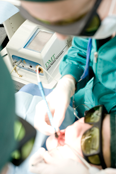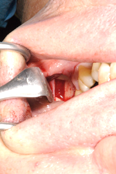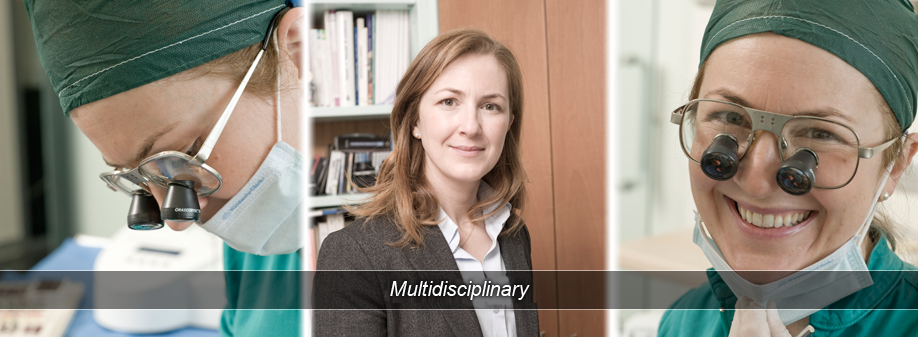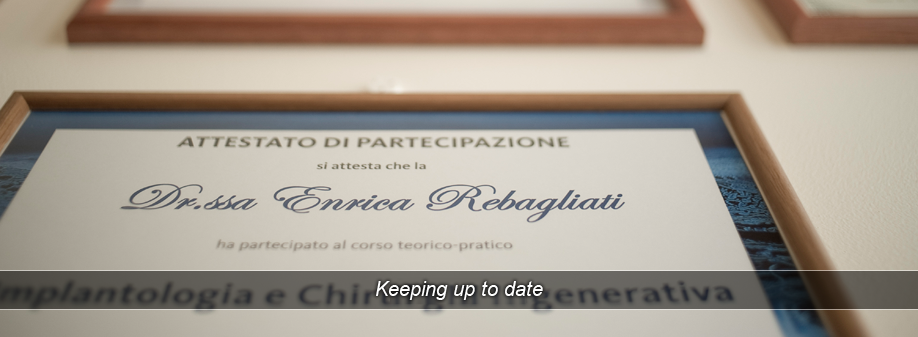Select:
Oral Surgery
The most common surgical procedures are represented by:
1. Simple and complex extractions. a tooth extraction is considered as complex when, for example, the roots of a multiroot tooth element are separated in order to make the extraction less traumatic and respectful of the tooth socket . This technique will allow a conservative post- extraction healing of the original site, making it ideal for the replacement of the tooth with an implant.
2. Extractions of an eighth tooth, included or not. The extraction of the eighth tooth ( also known as " wisdom tooth ") is often recommended not only for natural conservation, i.e. because of tooth decay, but more often for periodontal reasons , a malposition can cause loss of bone support in the preceding tooth. It can also be associated with follicular cysts or more simply can generate important pericoronitis and abscesses that will require several antibiotic treatments . Sometimes if the connections with the inferior alveolar nerve roots are not clearly detectable from the orthopantomography , a CAT scan may be required, which will allow a three-dimensional view of the site and so make the planning of the surgical procedure much safer.
If an eighth tooth appears to be in a particularly complicated position because of its tilt, rotation and morphology, a coronal and possibly a root split also are often recommended and obviously associated with osteotomy ( the removal of the bone that surrounds the tooth).

The post-operative step in a complex eighth tooth extraction, especially of a lower one, can be slightly distressful , but antibiotics , analgesic and possibly cortisone will make it more bearable.
3. Apicectomy or surgical endodontics: it consists of a dissection of the the apical third of the root affected by infection and the sealing of the new root apex . This technique is recommended if the non surgical endodontics ( traditional access ) has not been successful , i.e. the presence of large posts that can not be removed , or a particularly complex anatomy or instruments . The most suitable material for sealing the apical is a new cement with excellent hydrophilic properties and biocompatibility as well as sealants and antibacterial properties. (Mineral Trioxide Aggregate ).
4. Surgical lengthening of the dental crown (dental arch): a cavity damage or a fracture may involve the root portions of a tooth, sometimes close to or even below the bone crest. If the dental element is considered recoverable , in order to restore correctly the surfacing of the tooth may be necessary to remove it selectively and gradually remove also small amounts of bone of the dental elements nearby ( ostectomy and osteoplastic ): the result will be the exposure of healthy dental tissue , ideal for recovering the tooth with a conservative or prosthetic intervention.
5. Piezosurgery or ultrasonic surgery, it consists of a surgical technique that replaces the high speed handpiece in cutting the bone, using an innovative equipment and its specific inserts. This brings many advantages: cutting accuracy, less overheating of the bone and preservation of the vitality of the bone adjacent to the cut , a greater care for both nerves and blood vessels leads to a lower risk of complications , less risk of injuring the maxillary sinus membrane during procedures of great sinus lift but also during the technique of intracrestal mini lift. Piezosurgery is useful during dental extractions that require osteotomy , as well as during periodontics split crest with a sharp decrease in the intraoperative risks . Special inserts may also replace the cutters in setting the implant site.


6. Frenulectomy and excision of neoplasms in soft tissues. The use of the laser diodes, namely laser with a wavelength of between 810 and 980 nanometers, in the situations described above allows the simultaneous cutting and hemostasis of the tissues. This laser beam is particularly absorbed by soft tissues, rich in blood vessels. The use of laser in these type of interventions makes the application of stiches unnecessary and allows a very light healing process. Due to laser pain relief properties, a mild analgesia by contact (x eg lidocaine paste ) often ends up to be enough.

7. Elevation of the maxillary sinus: maxillary sinuses are natural hollows in the upper jaw, located in the area of the molar teeth. When these teeth are lost, there may not be enough bone left for implant placement due to the alveolar ridge resorption and / or expansion of the maxillary sinus. With an elevation of the maxillary sinus more bone tissue useful for implants can be regained. It can be made by intracrestal (mini lift ) or can be run with Caldwell Luc technique (major lift), making a small opening in the vestibular bone and lifting the Schneiderian membrane, then filling the opening with osteoconductive material mixed with autogenous bone. The most frequent complication in the elevation of the sinus techniques is the accidental puncture of the membrane. Small perforations during surgical procedure can be managed with the use of membranes, but larger perforations may require to suspend the procedure. In these cases, normal tissue repair processes allow a second attempt three months after the first procedure. The postoperative consequences include pain and swelling that are kept under control with antibiotic therapy (sometimes even by aerosols ), analgesics, and corticosteroids. The possibility of an implant procedure depends on the technique used and the residual bone of the patient. If the bone available is less than 4 mm the regeneration of the site will require at least 6 months.
8. GBR (Guided Bone Regeneration) the so called GBR are a whole series of provisions designed to allow the preservation or reconstruction of a ' suitable bone architecture, where the lacking of height and thickness makes it impossible to use an implant in the original bone.
Some examples of GBR are: interventions for ridge preservation, bone auto and mixed grafts for vertical or horizontal volume increase, and major sinus lift.


A GBR intervention requires the use of osteoconductive material , derived from bovine bone mineral component which guide the formation of new bone at the regenerated site, due to its affinity to human bone and its slow resorption rate. To get its maximum effect, the material must be stabilized with a guided clot through the use of resorbable membranes.











